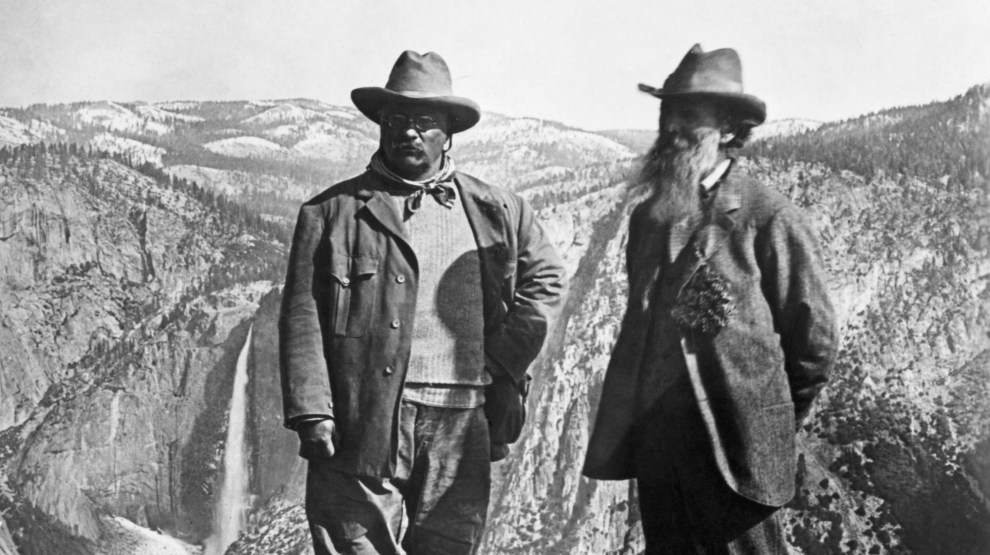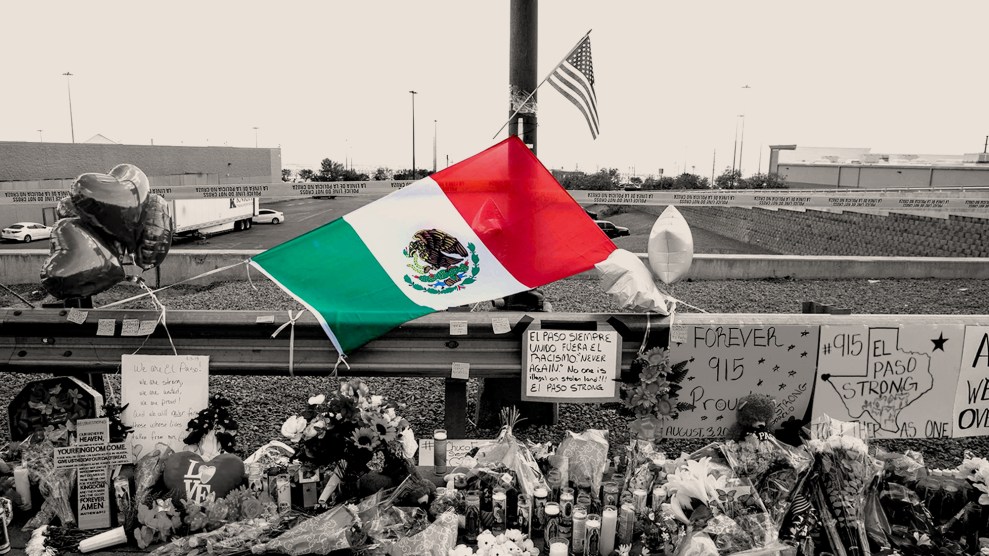
Theodore Roosevelt stands with naturalist John Muir on Glacier Point, above Yosemite Valley.Bettmann/Getty
This story was originally published by the Guardian and is shared here as part of the Climate Desk collaboration.
The environmentalist, white nationalist, and influential anti-immigration activist John Tanton died less than three weeks before the El Paso shooting. Tanton lived to see his movement shape much of modern US immigration policy, but not this latest violent turn.
A hate-filled document allegedly linked to the man suspected of killing 22 people in El Paso on 3 August echoed the kind of rhetoric generally favored by the far right—and also had a decidedly environmentalist, Tanton-like bent. The document praised the Dr Seuss character the Lorax, who says he speaks for the trees, and complained about the unsustainable overuse of paper towels. It concluded that the best course of environmental action would be mass murder.
A week prior, on an Instagram account reportedly linked to the alleged Gilroy, California, garlic festival shooter, he complained about migrant-driven sprawl. Months before, the Christchurch, New Zealand, shooter called himself an “eco-fascist.”
Long before this violence, researchers warned of “the greening of hate.” From Tanton’s anti-immigration nonprofit network to some of today’s avowed environmentalists, across the political spectrum, overpopulation and immigration in particular has been blamed for environmental collapse for over 50 years.
Anti-immigrant ideology has been part and parcel of the whole of American conservationism since the first national park was founded, in part to protect wild yet white-owned nature from Mexicans and Native Americans. National purity and natural purity were inextricably linked.
The current rise of eco-minded white supremacy follows a direct line from the powerful attorney, conservationist and eugenicist Madison Grant—a friend of trees, Teddy Roosevelt, and the colonial superiority of white land stewardship. Grant, along with the influential naturalist John Muir and other early Anglo-Saxon conservationists, was critical in preserving the country’s wildlands for white enjoyment. Muir, who founded the Sierra Club environmental group in 1892, was disturbed by the “uncleanliness” of the Native Americans, whom he wanted removed from Yosemite. Grant successfully lobbied, in equal measure, for the creation of protected national parks and the restriction of immigration by non-whites.
“Environmentalists were hardcore eugenicists. They were as committed to racial thinking as they were to protecting the great redwoods in California,” said Heidi Beirich, intelligence project director at the Southern Poverty Law Center.
That eco-xenophobia resurfaced in the 1970s as overpopulation and resource depletion was deemed the pre-eminent challenge facing the planet at the dawn of the anthropocene.
Published in 1968, The Population Bomb, by the Stanford University biology professor Paul Ehrlich, predicted that overpopulation would fuel worldwide famine and global upheaval.
Much of what Ehrlich predicted did not come to pass, but the book proved hugely influential in the nascent environmental movement. Global population growth was soon conflated with US immigration growth, and both were blamed for the coming collapse of Spaceship Earth. This argument inspired generations of eco-nativists, and the most influential anti-immigration advocacy network currently operating in the US.
In 1979, Tanton, a local Sierra Club official, founded the “centrist/liberal” Federation for American Immigration Reform (Fair) to further advance the overpopulation-as-environmental-degradation cause. He went on to co-found the Center for Immigration Studies. Tanton, who warned of a “Latin onslaught” that would degrade America’s culture and lands, is widely regarded as the founder of the modern immigration reform movement.
While Tanton was establishing his right-leaning network of anti-immigration organizations, new ecologists on the left were coming to the same conclusions he did about the answer to growing environmental crisis. “Deep ecologists” in the 1980s and 1990s argued that humans were just one of many species, and often an invasive and destructive one. Activist David Orton argued that limiting immigration “from a maintenance of biodiversity perspective…has nothing to do with fascists.” The deep ecologist Dave Foreman was a co-founder of the radical wilderness collective Earth First! before the group forced him and his increasingly anti-immigration ideologyout.
By the late 90s, the anti-immigration issue reached a fever pitch within the US environmental movement. The Sierra Club had grown exponentially in the preceding decades, and “population control” had been part of its core platform. A nearly decade-long power struggle ensued for control over America’s pre-eminent conservation group, as new members attempted to move away from the overpopulation argument, while longtime Sierrans and those in Tanton’s circle pushed the group to maintain immigration control as a core tenet.
They ultimately lost the Sierra Club in the mid-2000s, but anti-immigration groups associated with Tanton didn’t give up on attempting to influence eco-minded progressives. They ran ads linking overpopulation and climate crisis in mainstream newspapers and progressive magazines, from the New York Times to the Nation.
“The takeover attempts of the Sierra Club really woke people up to what was going on, but it still continues,” said Betsy Hartmann, Hampshire College professor emerita of development studies and author of “The America Syndrome: Apocalypse, War and Our Call to Greatness.” “The fact that it’s picked up—that’s the new twist.”
“We’re seeing the far right really take up ecological arguments again,” said John Hultgren, a Bennington College environmental politics professor and author of Border Walls Gone Green: Nature and Anti-immigrant Politics in America. “The rise of eco-fascism, I think, is very real.”
The right’s perspective on the climate crisis has generally been one of denial, and reliance on a fringe in the scientific community that maintains climate change is a natural process. According to available research, immigration control as climate control is a similar pseudoscience. By stopping immigration from countries with low per capita emissions to wealthier nations with high per capita emissions, this thinking goes, total environmental impact will be limited, as will further damage to US wildlands and biodiversity: fewer people means less sprawl and less resource use.
There is little actual science to bolster immigration control for ecological purposes. While there is evidence that population and economic growth in total increases global emissions, recent studies show no correlation between US immigrant communities and pollution.
Whether eco-nativists are using these arguments to greenwash racism, or they truly believe limiting immigration is the best way to pull the planet back from the brink, the results are the same. “You can be a genuine environmentalist and a genuine xenophobe—the two often do converge,” said Hultgren.
The El Paso manifesto echoed this logic, lamenting that it’s proven too difficult to change American consumers’ habits. “So population reduction is almost the low-hanging fruit, the simple solution to the crisis of climate change. That’s the argument that a lot of anti-immigrant environmentalists have made,” said Hultgren—but taken to a violent end.
Limiting immigration has certainly proven more politically palatable than regulating fossil fuel companies and corporate polluters under the current administration.
Tanton network groups have reportedly enjoyed a close relationship with the Trump administration and a great deal of influence over immigration policy. Trump’s adviser Stephen Miller and former attorney general Jeff Sessions have both been linked to Tanton groups. Former Fair officials and lobbyists have found a new home in the Trump administration. They include the former executive director of Fair, who is now the Department of Homeland Security’s citizenship andimmigration services ombudsman.
The eco-xenophobic rhetoric that Tanton and his supporters have traded in has proliferated across the right, straddling both arguments about population growth and outright racist beliefs that Latino immigrants, in particular, destroy nature. Long before he became the father of the Proud Boys, the Vice magazine co-founder Gavin McInnes espoused the ecological virtues of population and immigration control. In a 2003 Vice Guide to Happiness, McInnes offered some cause for optimism under President George W Bush: “Immigration is getting handled, which is helping the environmental problems overpopulation has caused.” In 2010, he grumbled about how the Sierra Club had turned away from the anti-immigration cause.
Richard Spencer’s “meta-political manifesto for the Alt-Right” advocated for a kind of conservationism in the white nationalist tradition. Right wing pundit Ann Coulter claimed Americans will have to choose between a “greening or browning” of America. Fox News host Tucker Carlson opined on air about the ecological impact of immigrants: “I actually hate litter, which is one of the reasons I’m so against illegal immigration.”
Online, an eco-fascist rhetorical revival has been wrapped in traditional white nationalist imagery and language, along with love for large guns. Using the hashtag #pinetreegang, supporters espouse the benefits of immigration control and share Lorax memes: just like Madison Grant and John Tanton before them, they purport to speak for the trees.
“What’s on the rise is white supremacy in general, but this is a pretty staple part of that ideology,” said Beirich. “When people hear [the Nazi nationalist slogan] ‘blood and soil’, they think of the blood, but the soil part mattered.”
One of the favored Pine Tree Gang phrases: “Bees, not refugees.”
The Sierra Club has backed far away from its xenophobic history, as have other environmental groups, which have since taken a more global perspective on climate crisis and environmental justice.
“It’s only now that the environmental movement is less racist than it’s ever been,” said Beirich.
“Environmental justice activists forced American environmentalists, most of whom were white and middle and upper class, to really confront this logic,” said Hultgren. “There’s been an ideological shift among mainstream and progressive environmental organizations to really reflect on the relationship between social inequality and environmental degradation.”
In 2013, the Sierra Club and the environmental activist group 350.org threw their support behind immigration. Earth First! has gone a step further, calling national borders “scar[s] on the earth.”
“The entire earth is a closed system, and the idea that people crossing borders is going to have a major impact on any individual environment is absurd,” said Veery Marten, an Earth First! Journal collective member. “The culprits of this white supremacist violence citing alleged environmental interests are almost always middle class white men who are not lowering their own carbon footprint. It’s not really about consumption, it’s about who’s allowed to consume and gate-keeping these resources.”
Environmental activism is still far from fully making amends for its history, though, and indigenous groups and people of color still feel sidelined in the movement.
“The environmental movement is increasingly reconciling with what it means to try to protect land on this continent when this land is stolen,” said Marten.
Mainstream environmentalists and the broader left may no longer espouse the benefits of limiting immigration, but many do warn of an impending global refugee crisis worsened by climate change that will in turn pressure societies unable or unwilling to grapple with an influx of new residents. In 2018, a World Bank report predicted more than 140 million climate migrants from Latin America, sub-saharan Africa and south-east Asia could be displaced by 2050. Concern for these migrants is often couched in calls for more open borders.
But Hartmann warns that proclamations of looming dystopia in the form of a mass climate-caused global refugee crisis put well-intentioned environmentalists on some shared ground with fear-mongering nativists, even as they’re attempting to convey a useful urgency about the future of the planet and the disproportionate impacts of climate crisis on the developing world.
“Not to say there won’t be climate-related migration, but I think that portrayal of migrants as climate change refugees, especially these mass movements of people, feeds into the anti-immigrant environmental worldview,” said Hartmann. “Alarmist hyperbole and stereotypes around climate conflict and even climate mass refugee dislocation is based on kind of old, racially and colonially charged stereotypes of poor people of color being more prone to violence in times of scarcity.”
A worsening climate crisis could easily become a cudgel for anti-immigration activists looking to use ecological preservation as an excuse to close borders, a means of gesturing toward doing something about climate crisis that aligns with the right’s other political goals.
“As it becomes more difficult for Republicans to deny that climate change is a thing, this is a really likely next move for the right in climate politics,” said Hultgren.
This story has been revised following publication.













